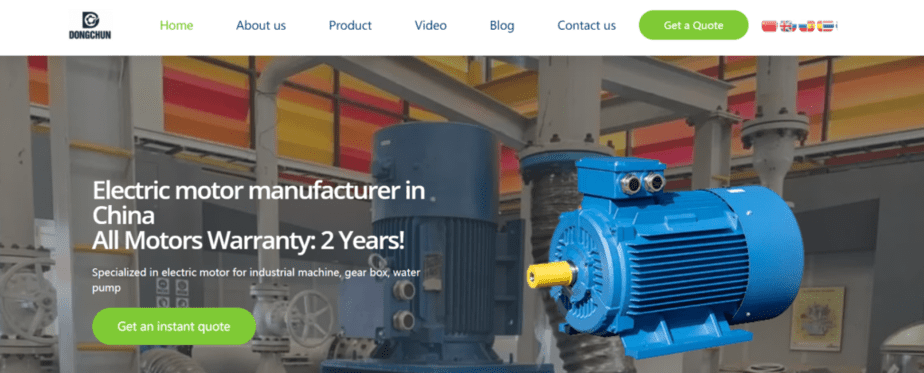የሞተር ነጠብጣብ እና ጫጫታ: ጨመቀ ካፕ excal ንዝረት እና ብሩሽ መሣሪያ ንዝረት

በቀደሙት ውይይታችን ላይ ለሞተር ነጠብጣብ አስተዋጽኦ በሚያደርጉ ላልሆኑ የጉዞዎች ምክንያቶች ላይ አተኩራተናል.
በዛሬው ጊዜ ሁለት ተጨማሪ ነጥቦችን እንመረምራለን-ጨርስ ካፕ ዘንግ እና ብሩሽ መሣሪያ ንዝረት.
በማኑፋክቸሪንግ ሂደት ውስጥ ንዝረት እና ጫጫታ በቅርብ የተቆራኘው በቅርብ የተቆራኘ ነው, በንቃትት ምክንያት ከሜካኒካዊ ጫጫታ ጋር.
ስለዚህ የሜካኒካዊ ጫጫታ ማቀነባበሪያ መካኒክ በሜካኒካዊ ንዝረት ማስወገድ ይኖርበታል.

ካፕ Copial ንዝረት እና ጫጫታ
የሜካኒካዊ ጫጫታ ምንጭ የሆነው የመጨረሻ ካፕ ውድድሮች ዋነኛው ምክንያት መንቀሳቀስ ነው.
በተለይም በመጨረሻው ካፕ ውስጥ ትናንሽ ዘንግ ተለዋዋጭ ዘመናዊነት የሚኖርበት ለአነስተኛ ሞተሮች ተገቢ ነው.

ብሩሽ የመሣሪያ ንዝረት እና ጫጫታ
ብሩሽ የመሣሪያ ንዝረት እና ጫጫታ የሚከሰተው በባቡር ሰበሩ ብሩሽ እና በብሩሽ ብሩሽ እና በብሩሽ, ብሩሽ ክፈፍ እና በብሩሽ በትር መካከል በቂ ያልሆነ ግፊት ጨምሮ በብዙ ምክንያቶች ነው.
በዲሲ የሞተር አሠራር ወቅት በብሩሽ እና በተጓዳኝ ወለል መካከል ያለው ተንሸራታች የመውጣወቂያ ሁኔታ በግራፊክ ፊልም እና ከአቧራ ቅንጣቶች የተሸፈነ ጠንካራ የኦክሳይጃ ፊልም ይፈጥራል.
ይህ ፊልም የሞተር መጓጓዣ አፈፃፀምን ብቻ ሳይሆን ነቀፋ እና ጫጫታም ጭምር ይነካል.
በተግባር, ፊልሙ በተጫነ ክዋኔ ወቅት በተጫነ ክዋኔ ወቅት በተንሸራታች ማገናኛ መውጫ ወለል ላይ በቀላሉ አይመስልም, በተጫነ ክዋኔ ውስጥ በቀላሉ አይመስለኝም, በመጫኛ እና በተጓዳኝ እና በጩኸት ጭማሪ መካከል.
በእርግጥ, በሚሽከረከር አረብ ብረት ውስጥ ዲሲ ሞተሮች, ከጨዋታው ሁኔታዎች ይልቅ ከ 6-10 ዲባ የበለጠ ጫጫታ የሚያስከትሉ የማይጫኑ ሁኔታዎች ከጠቅላላው ጊዜ ከጠቅላላው ጊዜ ከጠቅላላው ጊዜ ከጠቅላላው ጊዜ ከጠቅላላው ጊዜ ከጠቅላላው ጊዜ ከጠቅላላው ጊዜ ከጠቅላላው ጊዜ ከጠቅላላው ጊዜ ከጠቅላላው ጊዜ ከጠቅላላው ጊዜ ከጠቅላላው ጊዜ ከጠቅላላው ጊዜ ከጠቅላላው ጊዜ ከጠቅላላው ጊዜ ከጠቅላላው ጊዜ ከጠቅላላው ጊዜ ከጠቅላላው ጊዜ ከጠቅላላው ጊዜ ከጠቅላላው ጊዜ ከጠቅላላው ጊዜ ከጠቅላላው ጊዜ ከጠቅላላው ጊዜ ከጠቅላላው ጊዜ ከጠቅላላው ጊዜ ከ 50% በላይ የሚሆን የማይጫነ ሁኔታዎች.
በሜካኒካዊ ምክንያቶች የተከሰተ ንዝረት እና ተጓዳኝ ንዝረት የተለዩ ናቸው, እና የኋለኛው ደግሞ በሎፊው የሞተር ፍጥነቶች ሊታይ ይችላል (ብሩሽውን ለመዝለል ስሜት እንዲሰማዎት በማድረግ).
በተንሸራታች ዕውቂያ ጊዜ በተንሸራታች ግንኙነት የተነደፈ ብሩሽ የተንቀሳቀሱ ጥቃቅን ጥቃቅን ጥቃቅን ክስተቶች ከ 1000 እስከ -8000HZ ውስጥ ለውጦች በ MA ሞተር ፍጥነት ለውጦች ለውጦች, ከሜካኒካዊ ምክንያቶች እንዲለይ በማድረግ.

በተንሸራታች ዕውቂያ ውስጥ የተነደፈ ብሩሽ የተንቀላሚው ጩኸት ጫጫታ በብሩሽ አካልነትም ይነካል.
ለምሳሌ, የዲሲ ጄኔራሪዎች አዎንታዊ ብሩሾች በአዎንታዊው የመረጃ ጠጅዎች ላይ የሚወስዱትን የግራፊክ ብሩሽዎችን በመለየት እና በተጓዳኝ ወለል ላይ የሚወስዱትን የግራፊክ ብሩሽዎችን ለመለየት እና የሚያመለክቱ አሉታዊ ብሩሽ ፊልም ይፈጥራሉ.
የብሩሽ ክፍል ምርጫ በመጀመሪያ በተቀናጀ አፈፃፀም ላይ የተመሠረተ ነው, ነገር ግን ብሩሽ ያለው ንዝረት እና ጫጫታም ቢሆን ከግምት ውስጥ ይገባል.

ከሜካኒካዊ ጫጫታ በተጨማሪ, የአየር ጫጫታ ጫጫታ በሞተር ጫጫታ ቁጥጥር በተለይም ለከፍተኛ ፍጥነት ሞተሮች ውስጥም ጉልህ ችግር ነው. ለወደፊቱ ውይይቶች በዝርዝር ይህንን ርዕስ እንሸፍናለን.
ስለዚህ ርዕሰ ጉዳይ መማርን በመቀጠል፣ እውቀትዎን ማሳደግ እና በዛሬው ጊዜ እየተሻሻለ ባለው የቴክኖሎጂ ገጽታ ላይ ተወዳዳሪ መሆን ይችላሉ።
በቻይና ውስጥ ሙያዊ የኤሌክትሪክ ሞተር አምራቾች

ቻይና በአለም አቀፍ የኤሌክትሪክ ሞተር ኢንዱስትሪ ውስጥ ዋና ተዋናይ ነች ፣ በርካታ አምራቾች ከፍተኛ ጥራት ያላቸው እና ወጪ ቆጣቢ ሞተሮችን ለተለያዩ መተግበሪያዎች ያመርታሉ።
ዶንግቹን ሞተር ዓለም አቀፍ ደረጃዎችን ለማሟላት እና የደንበኞቻቸውን ልዩ መስፈርቶች ለማክበር የተነደፉ እና የተገነቡ ሰፊ የኤሌክትሪክ ሞተሮችን ያቀርባል.
ኩባንያው ነጠላ-ደረጃ እና ባለሶስት-ደረጃ AC ሞተሮችን፣ ብሬክ ሞተርስ፣ ማርሽ ሞተርስ እና ልዩ ሞተሮችን የሚያካትት ሰፊ የምርት ፖርትፎሊዮ አለው።







